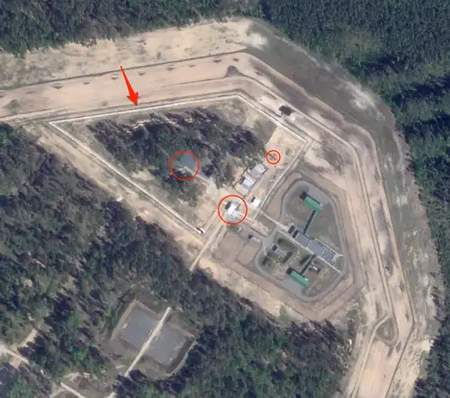At the end of May some satellite images discovered what Russia’s intentions were over the largest nuclear power plant in Europe. Now, in the midst of nuclear tensions in the wake of the war in Ukraine, new images from space have revealed an alarming pattern of expansion and renewal in five Russian nuclear bases that until now operated largely outside the international scrutiny.
Secret, or almost. I told it in an extensive INSIDER report through the images captured by the American company Planet Labs and analyzed by experts in strategic armament. The photographs show a series of new structures, reinforced roads, buried bunkers and multiple security perimeters that point to a systematic and stealthy investment in Russian nuclear infrastructure.
Although part of these improvements could be considered ordinary maintenance, the scale, the rhythm and nature of the constructions reveal something deeper: a reaffirmation of Russian nuclear power as a tool for deterrence, influence and survival in the face of the decline of their conventional forces.

Asipovichy base
Asipovichy: The new nuclear enclave. The Belarusian base of Asipovichy, which has gained notoriety since Putin and Lukashenko announced that Belarus could house Russian nuclear weapons, now presents triple fence, camouflaged tickets, covered ramps for eye discharge and a hidden bunker between trees. Although there are still no indications of active presence of eyelets, the infrastructure is ready to receive them from major deposits, such as Briansk’s.
A large platform and a new road suggest that rail transport would be the chosen logistics medium, in coherence with Russian standard procedures. In addition, a second complex in the same city shows mobile Iskander missile launchers, capable of carrying nuclear heads, hosted in recently expanded hangars, which reinforces the idea of a fully functional tactical node.

Base de Gadzhiyevo
Gadzhiyevo: Intercontinental missile hiding place. To the north, in the Naval Base of Gadzhiyevo, near the Arctic, the images show an intense activity in the mountainous complex where nuclear weapons are stored for strategic submarines. Previous photographs had already captured the raid of eyelets next to specialized cranes, and the new constructions seem to be hangars or workshops for missiles not yet armed.
A few kilometers, the Russian nuclear ballistic submarines of the northern fleet expect shipments in specially equipped docks, remembering that from this enclave attacks capable of devastating entire cities in minutes can be launched.

Kaliningrad base
Kaliningrad: The undercover arsenal. In the Russian enclave of Kalinningrad, between Poland and Lithuania, a deposit with multiple levels of fence has aroused the suspicions of analysts for years as a potential center of tactical nuclear weapons. The latest images confirm reforms in buried bunkers and the appearance of new structures, such as a small building identical to another in Asipovichy, whose function is still not clarified.
A few kilometers, a nuclear maintenance unit inherited from the Soviet era gives even more weight to the hypothesis of active storage of nuclear weapons, reinforcing the latent threat in one of the most sensitive areas of the NATO eastern flank.

Base de kamchatka
Kamchatka: Latent threat to Alaska. On the other side of Eurasia, Kamchatka’s remote peninsula, in front of Alaska, hosts facilities for the deployment of the Poseidon nuclear torpedo, a weapon propelled by atomic energy capable of traveling thousands of kilometers under the sea before detonating.
Although it is not clear if it is operational, the recent constructions in this base (including two new buildings possibly used as Wardly Warehouses) indicate a sustained advance in its preparation. The architectural similarity with other nuclear bases and the presence of triple fences in some structures reinforce the idea that atomic weapons or their launch systems are also housed here.
Novaya Zemlya: Risen test base. Finally, in the Arctic Archipelago of Novaya Zemlya, historical center of nuclear trials of the Soviet Union and the scenario of the detonation of the TSAR pump, the images capture a remarkable expansion in the Setny support base. New buildings and tunnels excavated in the mountain, along with old sealed accesses, suggest a revitalization of the complex as a subcritical experimentation center or as a platform ready for an eventual resumption of nuclear tests.
Although Moscow and Washington maintain a similar policy of keeping these places operational without rehearsing high -performance weapons, the intensification of work in Novaya Zemlya fems fears about the possible return of active essays.
The rebirth of a career. The simultaneous modernization of these five bases, some completely new (distributed between the Baltic, the Arctic, the heart of Belarus and the Pacific coast), illustrates how Moscow is reconstructing its strategic position under the pressure of a prolonged war in Ukraine and the deterioration of its conventional power. With an active arsenal estimated at 4,300 eyelets, the largest in the world, Russia is increasingly based on its nuclear inheritance as a shield and sword before NATO and the United States.
While and as we have told, Washington continues with its own nuclear tripod renewal program, and China discreetly increases its atomic capacity, thus configuring a global scenario where nuclear balance becomes the axis of deterrence, threat and strategic survival.
Imagen | Google Earth, Planet Labs
In WorldOfSoftware | The largest nuclear power plant in Ukraine. But Russia has taken it, and space has revealed its intentions
In WorldOfSoftware | We already know a hole that Russia has left in Ukraine: the Chernobil shield is still open and there is no money to close it
